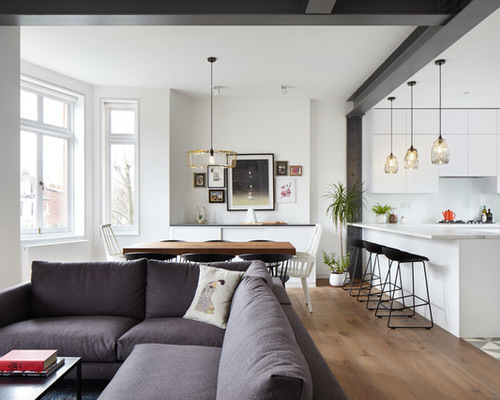November Home Maintenance Checklist

 November brings a transition to shorter days, colder weather and spending more time indoors. It also brings anticipation, planning and preparation for Thanksgiving and the upcoming winter holidays.
November brings a transition to shorter days, colder weather and spending more time indoors. It also brings anticipation, planning and preparation for Thanksgiving and the upcoming winter holidays.
Our checklist this month includes small, quick and easy tasks you can do now to get a jump start on your holiday hosting preparation so you can enjoy friends and family when they arrive.
Replace chair floor protectors. Prevent damage to your hardwood floors by adding or replacing floor protection pads to the legs of your chairs. Hardware stores sell felt self-adhesive protectors that are easy to use.
Clean garbage disposal. Run a few pieces of lemon rind with some ice cubes through your garbage disposal to keep it smelling fresh. The ice chunks scour the blades and scrape away debris. Products that clean and deodorize garbage disposals can also be purchased in retail stores.
Repair plumbing issues. Fix a slow drain or a stuck garbage disposal now rather than wait until you have a full house of guests.
Check bathtub caulk. Use diluted bleach to clean caulk that is moldy or mildewed. Avoid water damage to your home’s framing by replacing worn-out caulking as soon as possible.
Stock up for winter. Buy winter supplies like shovels and ice melting products now so you’ll be ready when the first snow falls.
Silence squeaky door hinges. Spray some cooking oil or other lubricant on door hinges. Be sure to first place a drop cloth on the floor to protect it and also blot the hinge with a rag to remove excess oil.
Clean kitchen exhaust fan filter. Remove kitchen exhaust fan screen and scrub with a mild detergent or run through the dishwasher.
Check fire extinguishers. Locate your fire extinguishers and be sure their gauge shows enough pressure.
Set aside a November afternoon to do the items on this home maintenance list, then sit back and enjoy a cup of hot apple cider. Happy Thanksgiving!
For more information about Windermere Evergreen please contact us here.
5 Lessons Home Renovations Can Teach You About Yourself

But a remodeling project, being a rather noteworthy life experience, can also teach you a lot about yourself. No, I’m not talking about your tastes or preferences (for example, you learn that you love the color blue on your walls or you learn that you really just don’t like remodeling). Rather, it can teach you about some characteristics you never knew you possessed, or at least never had the opportunity to focus on — the good and the bad. Here are some things you might learn about yourself.

Learn 1: Jane Lockhart Interior Design, original photo on Houzz
1. You’re more impatient than you thought. Remodeling will — I repeat, will — test your patience. It doesn’t matter whether you’re a dedicated yogi who can sit and meditate for hours at a time or a hobbyist who works late into the night tirelessly assembling detailed ships in bottles. Weather delays, unforeseen problems (wait, there’s mold behind that wall?), busy trade schedules — it’s almost impossible to have a remodeling project without a delay or two. And when it’s your project with the delays, you might just find yourself repeating the mantra of kids stuck in the family car during a road trip, “Are we there yet?” Or more specifically, “Are we done yet?”

Learn 2: Transitional Sunroom, original photo on Houzz
2. You’re adaptable. Bathroom remodels and kitchen remodels are notorious for, well, making bathrooms and kitchens unusable while they’re under construction. At the beginning this might seem like a major inconvenience (truth be told, it is!), but by the end you might be thinking “Who really needs a full kitchen?” After all, there are so many small appliances loved by college students and remodeling survivors alike — toaster ovens, microwaves, slow cookers, camping stoves.
Related: Brainstorm Ideas for Your Kitchen Remodel
Bathroom remodels can be easy to work around if you have another bath that isn’t under renovation, or a next door neighbor who is fairly generous, or membership in a gym with clean showers. Remember, creativity and adaptability are your friends. So embrace your inner MacGyver.

Learn 3: AMW Design Studio, original photo on Houzz
3. You want in on the action. It starts small: At first, you’re just chatting with your contractor about the status of your project — normal stuff. But as time goes on, you can’t help but ask questions about the more technical side of things. Some people might find details about tile installation eye-rollingly boring, but you’re intrigued.
Related: Read Reviews to Find the Best General Contractor Near You
Suddenly, you find yourself searching for home improvement how-to books and classes on design. You may even start planning your second project (which you’re considering doing yourself) or looking for houses you think you’d like to flip. Watching your own home transform before your very eyes has been an exciting process, no doubt, and now you’re ready to try your hand at it. Don’t be surprised if at first you just want the process to be over, only to find that you never want it to end.

Learn 4: Deville Custom Homes, original photo on Houzz
4. Your relationships can (probably) weather any storm. If the space you’re remodeling is a place that you share with someone else (whether it be your spouse, children or others), it’s likely that you’ll feel a little more stress than if you were just remodeling your own personal space.
Every stress that you feel about the remodel, they probably feel as well. Every worry you have about budgets and schedules and paint colors, they have too. Pour all that stress into a small group of people who live together, and, well … things can get messy.
But when you finally see the light at the end of the tunnel, you realize that all that pressure was worth it, because you and your people have a beautiful new space to use for years to come. It probably took some compromise and communication to get there, but now that you’ve finally made it, you know you’re that much stronger because of it.
Or not. I don’t want to be a Debbie Downer, but what you might discover about yourself is that you can’t collaborate with the person you’re with. Remodeling is like a stress-test on relationships — for good or ill.

Learn 5: Tiffany McKenzie Interior Design, original photo on Houzz
5. You’re fearless. I’ll tell you this much: It takes a lot of inner strength to not freak out when you see someone you’ve never met come through your front door with a hammer. Remodeling can make some people stronger. Once you see your home demolished before your very eyes by strangers wielding tools and driving heavy construction equipment, your definition of “scary” changes a little.
Obviously, this isn’t an all-encompassing list, nor is it supposed to mean that you will find yourself relating to every point. You may or may not feel the urge to become an amateur remodeler. You might (understandably) still get freaked out at a stranger coming into your home with a hammer. Remodeling is a personal journey, full of personal discoveries and accomplishments and all that good stuff. The only way for you to truly know how it will affect you is for you to experience it yourself. But whatever happens, you will learn more about yourself than you have in a long time.
If you are looking for a qualified Real Estate Agent please contact us here.
A Beginner’s Guide to Managing a Remodel


YourSpace Contractors, original photo on Houzz
Become a list writer. Making lists is key when it comes to project management. It’s the only way to properly organize your thoughts and prevent any details from being forgotten.
The most important list is your scope of work, or specifications, document. This is basically a detailed list of everything to be done, from start to finish. If you’re dealing with one main builder who’s organizing all the work, then you’ll need to make sure he or she gets a copy, so the goals are clear and all the information is provided.
Also, having detailed specifications makes it easier if you want to obtain multiple quotes, and you’ll know it’s a fair comparison since all the builders will be quoting using the same criteria.

frenchStef Interior Design, original photo on Houzz
Make sure you’re all on the same page. If you’re coordinating separate subcontractors (cabinetmaker, plumber, electrician), then it would be worth indicating who’s responsible for each task. Give a complete copy of the specifications to all of them, so they’re all aware of what everyone is doing. Discuss the specifications with your subcontractors since they may be able to provide help and advice. A schedule is also useful, so you can keep track of progress and everyone knows who’s going to be on-site on which day.
With prior knowledge that a partition wall will feature some lighting, for instance, the builders will know to leave the stud frame open for the electrician to run the wires through before it’s boarded up and plastered over. Trying to feed wires through after the fact is much harder, takes longer and risks unnecessary damage.

Sian Baxter Lighting Design, original photo on Houzz
Break into subsections. In addition to your main specifications, it’s a good idea to have sublists for each separate element of your design. For example, your main specifications may say “install 6 x recessed LED downlights in ceiling,” but your lighting specifications will detail where they are to be positioned, the type of bulb, the hardware finish and so on. The more information you provide, the more accurate your quote should be and the less likely it will be for mistakes or misunderstandings to occur. It will also minimize any unexpected costs.
This bathroom has a minimalist elegance, but it’s far from straightforward. This project would have required a builder’s spec, including layout and elevation drawings with dimensions, an electrical spec with lighting plan, a plumbing spec with layout drawing, and a decorating spec — phew!
Plan like a pro. Finalize your design before starting any work, rather than trying to do it as you go along. The process will be much more enjoyable without constant deadlines presenting themselves, and if you haven’t planned, you may find your options restricted based on work that’s already taken place.
Take a couple of weeks to put it all together, write your specifications, draw up the plans, get everything ready and make all the decisions before proceeding. This will save you time and money along the way, and significantly reduce stress levels during the project.
This clever design features well-thought-out lighting and custom cabinetry. Careful consideration would have been given to where to position the outlets, radiators, lights, switches and other details.

Yellow Letterbox, original photo on Houzz
Never assume. You know the saying. When writing your specifications or drawing your plans, never assume that someone else will know what you want unless you explicitly state it. Include every tiny detail, no matter how picky it may seem. As well as avoiding mistakes, it also prevents any disputes over what is and isn’t included in the quote.
This bathroom just wouldn’t have looked the same if white grout had been used, for instance. You may think it would be absurd to even consider using white grout in this case, but if you haven’t asked for dark gray, you can’t expect it and you can’t assume that you will be asked what color you want. White is standard, and a tiler may use it if nothing has been specified.
Stand by for decisions. Your builder will present many questions and decisions to you along the way. Which tiles do you want on the walls? Where do you want these wall lights? What color do you want on the baseboards?
Your best bet will be to try to pre-empt as many of these decisions as possible and have the answers ready or, even better, provide the information in advance. Making these decisions under pressure can lead to impulse moves you may regret later. However, taking too long could hold up the project, costing you time, money and the patience of your builder. No one wants an unhappy builder.
Inevitably, there will be some questions you couldn’t have anticipated, but if you communicate well with your contractors, they should, where possible, give you time to make a decision without holding up the project. Don’t be afraid to ask their opinion on the best course of action, but don’t feel pressured to compromise on the design if you don’t want to.

Brilliant Lighting, original photo on Houzz
Give yourself time to deliver. This is one of the classic pitfalls, so take note. When pulling your design ideas together and deciding which products and materials to use, make a note of the lead times. Many pieces of furniture are made to order and can have lead times of up to 12 weeks, sometimes longer. Similarly, tile and natural stone can take much longer than expected to arrive, and products from abroad can encounter holdups during transit.
This chandelier was custom-made for the project and looks fantastic. This is no last-minute, off-the-shelf, next-day-delivery job. It can be a huge shame if you’ve spent hours, days, weeks choosing the perfect product, but when you come to order it, you find that it will take too long to be delivered, perhaps time you can’t afford. Then you have to decide whether to hold up the work or pick something else based on the fact it can be delivered quickly.
Find a Bathroom Vanity for Your Bath Remodel
Factor in a contingency. Even when you have the very best of intentions, issues that you couldn’t have predicted may arise during your project. So it’s a good idea to factor in a 10 percent contingency within your budget for these matters, especially with old buildings. Who knows what condition the walls are in behind those kitchen cabinets before you rip them out? Or what may be lurking underneath that carpet when you pull it up?
In these situations, it’s important to expect the worst and don’t let it throw you off your game. You are a project manager extraordinaire, and you’ve totally got this. Just accept that these things happen, find out what the options are and make a decision. Your contractors will be able to advise on what to do, so harness their expertise and trust them to help you find the right solution.

Elayne Barre Photography, original photo on Houzz
Call in the cavalry. If you choose to manage your project yourself, it’s certainly an enjoyable and rewarding process, but it also takes a certain type of person. You have to be organized, calm under pressure, strategic and confident — not to mention being able to afford the time to plan, coordinate and oversee the work.
If you have qualms about taking it on yourself, then consider hiring a project manager. Yes, there will be a fee, but consider that a badly managed project can cost you time and money, and you may not achieve the results you were after. A pro will take care of everything and allow you to rest easy, knowing you’re in safe hands.
If you are looking for a qualified Real Estate Agent please contact us here.
At Home in the Outdoors

 More than 80 percent of Americans say they want an outdoor living space where they can relax and entertain. And it’s no wonder why. Outdoor spaces extend your livable space, add visual interest, and increase not only your quality of life, but also the overall value of your home. (In some cases, the increase in your home’s value can cover most or all of the cost to create the new space.) Here are some options to consider:
More than 80 percent of Americans say they want an outdoor living space where they can relax and entertain. And it’s no wonder why. Outdoor spaces extend your livable space, add visual interest, and increase not only your quality of life, but also the overall value of your home. (In some cases, the increase in your home’s value can cover most or all of the cost to create the new space.) Here are some options to consider:
DECK
Decks are still the most popular outdoor living spaces, not only because they work so well for entertaining and relaxing, but also because they have the highest return on investment (see the Tips column for data).
Surprisingly, wood decks (made of cedar or pine) are actually the better financial investment, because building with Trex or other popular composite products costs considerably more, yet doesn’t increase the home’s value by as much.
Expanding and re-configuring your current deck is another option that’s popular today. The contractor will typically remove the old face boards, extend the underlying structure, and then put down the new decking. This is also an opportunity to add built-in furniture, privacy screens, even plumbing and electricity.
PATIO
Running a close second to decks – in both popularity and investment return – are patios. With a patio, you can relax and entertain at ground level, which can afford more privacy in urban areas, and allows you to be more engaged with the surrounding plants and landscaping.
Typically made of brick, concrete, or stone, a patio also comes with far fewer maintenance and repair issues than a deck. Plus, patios are generally easier and less disruptive to construct – which is why they’re often about 30 percent less expensive to have professionally built.
GAZEBO
For those who want even more privacy, as well as shelter from the sun and protection from mosquitoes and other pests, there’s the gazebo. Available with walls or as an open-air design, with screening or not, these modestly sized, affordable backyard structures can be built from scratch or purchased as a kit (for assembly by a do-it-yourselfer or a professional).
Popular in the Midwest for decades, gazebos have made their way west as homeowners here have discovered how nice and easy they are for creating a shaded spot for reading, relaxing, and backyard gatherings.
OUTDOOR KITCHEN
People tend to gather naturally in the kitchen. And when the kitchen is outdoors, it creates an ideal opportunity to mix, mingle and interact in the open air. Other reasons why cooking outdoors makes so much sense: less kitchen cleanup, the house stays cooler during the summer, and grilled food just tastes better.
Some may think an outdoor kitchen is only for cooks who host large parties, but homeowners who go this route say they’re more of an extension of the home, and great for daily use.
Designs for outdoor kitchens range from the simple (a grill, limited counter and cabinet space, and maybe a prep sink) to truly independent entities with a refrigerator, an elaborate grill, warming oven, freestanding island with storage space, rolling cart stations, and even a dishwasher. Depending on how elaborate your design, you may be able to list it as a second kitchen when selling your house.
SIX PLANNING SUGGESTIONS
- Before meeting with contractors, gather photos of designs and ideas that you like; this will make it much easier to communicate your ideas.
- Make sure the materials you plan to use, as well as the overall size of the structure, will be harmonious with your home’s current look and feel.
- Give serious consideration to a roof – which will likely add significantly to the cost, but will also provide much-needed shade on hot days and protection from rain and inclement weather. In fact, to ensure things are structurally sound and architecturally appealing, start with the design for the roof first, then set your sights on the roof supports and structure below.
- Incorporate lighting into your design, which will extend its usability into the evening and throughout the seasons.
- Consider convenience, comfort, and longevity when choosing materials. For example, a floor made of dirt or stepping stones may last forever, but one made of wood or concrete is much easier to clean and arrange furniture upon.
If you’re eager to live a healthier lifestyle and reconnect with family and friends, as most people are today, it’s time to consider an outdoor living space. For more information on Windermere Evergreen please click here.
 Facebook
Facebook
 X
X
 Pinterest
Pinterest
 Copy Link
Copy Link

 Many of us dream of getting a better job. But when a promotion or new job opportunity comes with a request to relocate, the result can be very disruptive to your home life. There’s a lot to consider when making this kind of move, such as do you have a home to sell? Are you planning to rent or buy when you relocate? Is your employer covering some of the costs of your relocation? Should you hire a moving company or handle the move yourself? Following is an overview of some of the most important factors you should take into consideration when relocating.
Many of us dream of getting a better job. But when a promotion or new job opportunity comes with a request to relocate, the result can be very disruptive to your home life. There’s a lot to consider when making this kind of move, such as do you have a home to sell? Are you planning to rent or buy when you relocate? Is your employer covering some of the costs of your relocation? Should you hire a moving company or handle the move yourself? Following is an overview of some of the most important factors you should take into consideration when relocating.
 If you are looking around your home and thinking to yourself that it’s time to de-clutter, the summer months provide an ideal time to hold a garage sale. But if that sounds like too big of an undertaking, there are other options available to you thanks to popular resale sites like eBay and Craigslist. And if even that sounds like too much effort, you might also consider donating lightly used items to charity or sending them off to the dump. Here are some questions to help you decide which method is best for you.
If you are looking around your home and thinking to yourself that it’s time to de-clutter, the summer months provide an ideal time to hold a garage sale. But if that sounds like too big of an undertaking, there are other options available to you thanks to popular resale sites like eBay and Craigslist. And if even that sounds like too much effort, you might also consider donating lightly used items to charity or sending them off to the dump. Here are some questions to help you decide which method is best for you.
 Whether you’re buying or selling, accurately pricing a home requires professional assistance from someone who knows the neighborhood.
Whether you’re buying or selling, accurately pricing a home requires professional assistance from someone who knows the neighborhood.


 After succumbing to the “Great Recession” ten years ago, the stock market has made a comeback. So, does that mean you should forget about buying a new house and invest in stocks instead? The answer to that question, say experts, depends on your investing savvy, your financial discipline, your age, and your current financial situation.
After succumbing to the “Great Recession” ten years ago, the stock market has made a comeback. So, does that mean you should forget about buying a new house and invest in stocks instead? The answer to that question, say experts, depends on your investing savvy, your financial discipline, your age, and your current financial situation.
 Are you thinking about downsizing but don’t know how to make the tricky transition work? How do you buy a new place before you sell your current home?
Are you thinking about downsizing but don’t know how to make the tricky transition work? How do you buy a new place before you sell your current home?